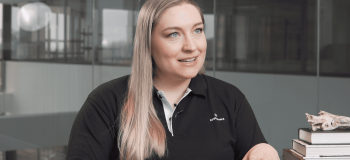In the fast-paced world of technology, we want everything and we want it now! All kidding aside, before we dive headfirst into any new project, we first must ask ourselves – “What problem is it we’re trying to solve?”
This may seem like a trivial question, but product management and product development cycles depend on engineers having absolute clarity on the problem they’re trying to solve. Without it, what may seem simple can become very complex to grasp.

Clarity is Key
Let’s begin with a thought experiment. The CEO of a new start-up declares, “We need to solve the problem of being able to make anything anyone says into a microphone appears on a monitor.” The lead engineer thinks to herself, “Hey, that’s an easy problem to solve. I can whip up a solution in a few minutes.” She proceeds to develop a system that utilizes Alexa to handle the translation from a USB microphone connected to a computer, which feeds to a Web Front-End that displays it on a screen. Being an overachiever, she also adds controls to allow the user to choose their font and colours.
The CEO is then given a demonstration, as the engineer proudly displays her work. As the demo progresses, the CEO begins to sullenly sink into their seat in disappointment. Without wanting to stomp all over the engineer, the CEO declares this really isn’t what they were looking for, as it won’t properly address the needs of the company’s customer base. The puzzled engineer responds, “But I solved the problem. You wanted to display on a monitor what anyone says into a microphone. My product does that; in fact, it even allows the user to change colours and fonts!”
The CEO responds, “Yes you did, but how does that help a person who is hard of hearing to interact with people more naturally? And this won’t work at all if the user isn’t connected to the internet.”
So … what can we learn from this story? I’d argue it presents two major conflicts. The first is that the CEO didn’t clearly state the problem, even though she does state what she already imagines the solution will be. The engineer is also at fault, as she proceeds without actually understanding the purpose behind what she’s doing.
In essence, this interaction demonstrates the implications – at a product management and engineering level – of Simon Sinek’s “Start with Why”. In this case, the “Why” is improving the lives of people with a hearing disability. The “How” is to build solutions that help them and the “What” is a solution to allow them to interact with others more naturally by transcribing speech to text. Both parties in this story are guilty of jumping directly to the “What” without having an agreement on “Why” and “How”.
How does this relate to ApplyBoard?
In a previous post, I touched on how ApplyBoard’s Engineering Team is currently focused on microservices, built on Kubernetes, running in AWS, and using the latest and greatest version of Golang. Now, let’s ask ourselves a few questions, starting with “Why” – namely, why does ApplyBoard exist?
Students around the world work hard so they can get accepted into the top schools and achieve their dreams of a rewarding career and a bright future. Unfortunately, many students see their dreams cut short; not because they aren’t smart enough or didn’t work hard enough, mind you. In many cases, the top schools in their home countries don’t have enough available spots. To make matters worse, the process of searching, researching, applying, and enrolling in schools abroad can be complicated. Often, the process is lengthy and filled with gaps due to a lack of information, as well as plenty of misinformation.
ApplyBoard’s mission is to empower students around the world to access the best education.
So “how” does ApplyBoard plan on achieving its mission? We can enable and empower students with:
- Timely and accurate information about available programs and requirements
- Provide systems and/or services to aid students throughout the entire process.
“What” does ApplyBoard do? We provide the information and required timely aid to students. To achieve this, ApplyBoard needs to build out both its staff and knowledge base, as well as systems capable of gathering, organizing, and intelligently utilizing information in a timely and context sensitive manner.
Our services enable users to easily search for accurate, up-to-date program information based on multiple factors, including academic and eligibility requirements. Additionally, we help students through what can be a complex and confusing application process. We do this by ensuring that the appropriate documentation, fees, timelines, and other requirements are understood and satisfied in a timely, efficient manner.

Understanding the Student Journey
Okay, that’s the marketing spiel. Any technical folks still hanging in there are probably saying to themselves, “Yeah yeah, whatever you said. But c’mon, what do your systems actually do?”
Don’t worry, we’ll get to that. But as alluded to earlier, it’s important to first understand and know the purpose for a technology’s existence. After all, the most elegant, perfectly-executed system in the world is useless if nobody actually cares about it.
In other words, before we go thinking “We’re so innovative! We built the best search and automated process handling ever,” we need to circle back to, “What problem are we trying to solve. In this case, we need to ask ourselves, “What is the biggest pain point for international students?”
Is it finding information about what programs even exist?
Understanding the information?
Figuring out how to apply?
Figuring out if you meet the requirements?
Where do we start? We start by understanding the student journey.
The very first step in this journey is for a student to begin looking into studying abroad. The student will typically conduct a preliminary search themselves based on the following criteria:
- Geographic Area
- Programs available
- Programs they might be eligible for
- Tuition and fees
- Other information about the school
From ApplyBoard’s collective first-hand experience, we know that the frustration begins right at this first step. Students often run into the problem of finding partial, incomplete, outdated, or inaccurate information. Students often end up making an initial decision based on the information at hand, which could lead them a sub-optimal set of choices.
This gives us a very good starting point. Specifically, ApplyBoard can step in and be the trusted resource to provide accurate and comprehensive information about the programs available. However, this creates a whole new set of problems to deal with …
Thank you for reading this instalment of #EducateTheEngineer. In the next post, we’ll look at the next step in the student journey to explore how that stage is even more problematic for students.
—
Hiep Vuong
Vice President of Engineering
ApplyBoard





